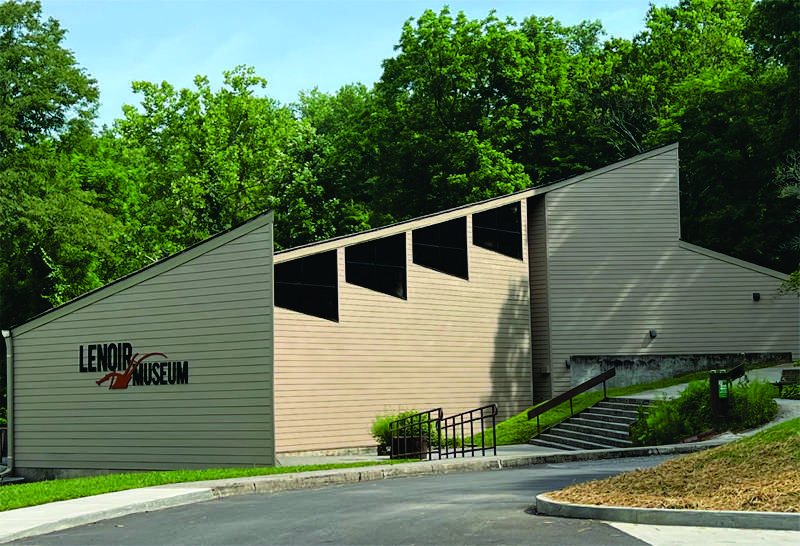Lenoir Museum anniversary event is Thursday

The Lenoir Museum in Norris will celebrate its 50th anniversary on July 10. It opened on July 10, 1975, on land across Norris Freeway (U.S. 441) from the Clinch River donated to the state of Tennessee by TVA. (photo:G. Chambers Williams III )
Featuring hundreds of artifacts representing Appalachian history, the Will G. and Helen H. Lenoir Museum on Norris Freeway (U.S. Highway 441) opened to the public on July 10, 1975.
It’s on land that the Tennessee Valley Authority donated to the Tennessee state park system, just across the highway from the Clinch River below Norris Dam.
The museum is on property that is part of Norris Dam State Park, adjacent to the Crosby Threshing Barn and 18th-cCentury Rice Grist Mill along Lower Clear Creek Road.
Most of the museum’s displays consist of everyday items of early Appalachian life, which were collected by the Lenoirs over several decades.
Among them are Indian artifacts, fine china, pressed glass, furniture, farm implements, bottles, bells, baskets, rocks, historical documents and more.
“Mr. Lenoir enjoyed sharing his stories with museum visitors well into his 90th year, as he and Helen had done in their home for years before the museum opened,” according to a description of the facility on the state parks website (tnstateparks.com/parks/activity-detail/lenoir-museum).
“Learn what a stanhope is, what a lithopone is, how a ‘tar rock’ was used, and see how fascinating mousetraps are,” the website entry says.
Live entertainment will be part of Thursday’s celebration, just like the music performed most weekends at the museum.
“Each Sunday, area musicians bring their guitars, fiddles, banjos, and other instruments to the museum to share East Tennessee traditional music,” the website notes. “The place comes alive as listeners and performers enjoy the fun. Everyone is always welcome to bring their own instrument or just enjoy the music.”
The celebration will be held from 9 a.m. to 5 p.m., which are the museum’s normal hours.
Besides the music, other activities on Thursday will include craft tables, guest speakers, tributes to the Lenoirs, and a cake cutting, according to the park’s Facebook page.
There is no admission charge for the Lenoir Museum, which is open year-round every Wednesday through Sunday.
Besides the artifacts collected by the Lenoirs, the museum offers occasional special exhibit, such as the one in 2021 called “Families of the Valley,” set up to honor the nearly 3,000 families displaced by Norris Lake during its construction in the early 1930s.
That exhibit was designed to tell the stories of the people whose lives were uprooted when TVA built Norris Dam, which was completed in 1935, creating Norris Lake from waters of the Clinch and Powell rivers.
The Tennessee state parks website notes that “The Lenoir Museum contains artifacts from Early Americana which were collected for [more than] 60 years by Will G. Lenoir and his wife Helen, and donated by the Lenoirs to the state of Tennessee.
“The Lenoirs strongly desired that the rapidly changing times not wipe out an appreciation of the hard work and ingenuity that were a part of everyday life. They searched for, bought and stored away artifacts to preserve an understanding of that life.
“It was not just the artifacts they collected, but also the stories of the people behind them and their use. Many thought that Mr. Lenoir was ‘crazy’ to pay for items they had discarded to their barn or shed.
“Numerous items in this museum would have been lost had they not caught the eye of the Lenoirs,” the website entry continues. “Sometimes only one board from a wooden bucket would still be visible, or one chair leg, and Mr. Lenoir would scratch in the dirt, straw, or worse, searching for the other pieces.
“He occasionally found all the parts and put them back together again. When all the parts could not be found, he would make parts necessary for restoration, or locate an artisan who could do the job.
“In his searches throughout the countryside, he discovered a few [craftsmen] skilled in producing items such as wooden churns no longer in use. He brought these artists to the attention of others and encouraged appreciation of the old time crafts.”
One key attraction in the museum is a barrel organ.
“Some items Mr. Lenoir would follow for years trying to buy, such as the barrel organ,” the website says. “But it was not just treasures of the rich he sought; he was interested in everyday tools such as the spittoon kicked back and forth by a couple who lived near the museum site. It was the Lenoirs’ dream to see their collection kept together and displayed for the public’s enjoyment and enrichment.”

